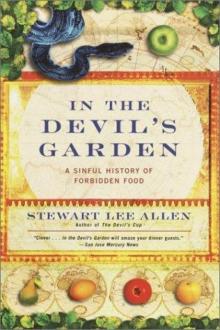In the Devil's Garden: A Sinful History of Forbidden Food 

Genre: Other6
Published: 2003
View: 1962
Read OnlineRead In the Devil's Garden: A Sinful History of Forbidden Food Storyline:
Amazon.com ReviewLust, gluttony, pride, sloth, greed, blasphemy, and anger--the seven deadly sins have all been linked to food. Matching the food to the sin, Stewart Lee Allen's In the Devil's Garden: A Sinful History of Forbidden Foods offers a high-spirited look at the way foods over time have been forbidden, even criminalized, for their "evil" effects. Food has often been, shockingly, morally weighted, from the tomato, originally called the love apple and thought to excite lust; to the potato, whose popularity in Ireland led British Protestants to associate it with sloth; to foods like corn or bread whose use was once believed to delineate "lowness," thus inflaming class pride. Allen's approach to this incredible history also includes tales of personal journeys to, for example, a Mount Athos monastery, where a monk reveals the sign of Satan in an apple, and to San Francisco to investigate dog eating. If his history is sometimes too glancing and facetious, even beyond the sensible need to entertain, it is always fascinating.The book also features "forbidden" menus--such as the one devoted to gluttony that includes an entire steer stuffed with a whole lamb, stuffed with a pig, stuffed with a chicken, and served with sausages--and quite doable and delicious recipes, such as a dynamite hot and sweet banana ketchup and Lo Han Jai, a mushroom-replete vegetarian feast. But the real focus is on the human response to a primal pleasure--eating--and the way people have sought to control it, in every society and every culture, through prohibition. It's quite a tale. --Arthur BoehmFrom Publishers Weekly"When I pluck a few leaves [from my little basil bush] for my tagliatelle, I make sure to scream obscenities at its fuzzy little head just like the Italians used to." Unaware of basil's complicated past, some cooks might use the herb with carefree abandon, but Allen, author of The Devil's Cup: A History of the World According to Coffee, knows better. When it arrived in Europe from India around the fourth century B.C., basil came wrapped in a tale of fatal passion, which eventually morphed into the belief that a person who smelled the herb would go mad and curse up a storm. Allen's conceit is to take dozens of such tales and categorize them as one of the seven deadly sins: the section on "Lust," for instance, looks at the forbidden fruit in the Garden of Eden; the section on "Sloth" covers the potato and its supposed tendency to turn the Irish into lazy fornicators; the section on "Blasphemy" recounts how 16th-century Catholic priests roamed the streets of Madrid sniffing for Jewish cookery. While the historical and cultural links between food, sex and religion make for fascinating reading, Allen's structure is forced at times: it is difficult to understand why Allen places France's obsession with bread and class in the section on "Sloth." The book's tone flip and entertaining seems geared to the casual foodie, but its breeziness is often frustrating: Allen devotes only three pages, for example, to the potent trio of food, lust and homosexuality. Cooks may find Allen's unusual assortment of recipes from around the world as well as his recommendation on where to find the world's best potatoes (and it's not Idaho) to be the best part of the book. Copyright 2001 Cahners Business Information, Inc.Pages of In the Devil's Garden: A Sinful History of Forbidden Food :